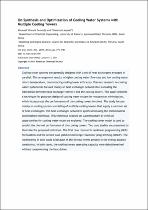 ResearchSpace
ResearchSpace
On synthesis and optimization of cooling water systems with multiple cooling towers
JavaScript is disabled for your browser. Some features of this site may not work without it.
- ResearchSpace
- →
- Research Publications/Outputs
- →
- Journal Articles
- →
- View Item
| dc.contributor.author |
Gololo, KV

|
|
| dc.contributor.author |
Majozi, T

|
|
| dc.date.accessioned | 2011-12-13T10:11:55Z | |
| dc.date.available | 2011-12-13T10:11:55Z | |
| dc.date.issued | 2011-01 | |
| dc.identifier.citation | Gololo, KV and Majozi, T. 2011. On synthesis and optimization of cooling water systems with multiple cooling towers. Industrial & Engineering Chemistry Research, Vol 50(7), pp 3775–3787 | en_US |
| dc.identifier.issn | 0888-5885 | |
| dc.identifier.uri | http://pubs.acs.org/doi/abs/10.1021/ie101395v | |
| dc.identifier.uri | http://hdl.handle.net/10204/5394 | |
| dc.description | Copyright: 2011 American Chemical Society. This is an ABSTRACT ONLY | en_US |
| dc.description.abstract | Cooling water systems are generally designed with a set of heat exchangers arranged in parallel. This arrangement results in higher cooling water flow rate and low cooling water return temperature, thus reducing cooling tower efficiency. Previous research on cooling water systems has focused mainly on heat exchanger network thus excluding the interaction between heat exchanger network and the cooling towers. This paper presents a technique for grassroot design of cooling water system for wastewater minimization, which incorporates the performances of the cooling towers involved. The study focuses mainly on cooling systems consisting of multiple cooling towers that supply a common set of heat exchangers. The heat exchanger network is synthesized using the mathematical optimization technique. This technique is based on superstructure in which all opportunities for cooling water reuse are explored. The cooling tower model is used to predict the thermal performance of the cooling towers. Two case studies are presented to illustrate the proposed technique. The first case resulted in nonlinear programming (NLP) formulation and the second case yield mixed integer nonlinear programming (MINLP). The nonlinearity in both cases is because of the bilinear terms present in the energy balance constraints. In both cases, the cooling towers operating capacity were debottlenecked without compromising the heat duties. | en_US |
| dc.language.iso | en | en_US |
| dc.publisher | American Chemical Society | en_US |
| dc.relation.ispartofseries | Workflow request;7719 | |
| dc.subject | Cooling water systems | en_US |
| dc.subject | Multiple cooling towers | en_US |
| dc.subject | Wastewater minimization | en_US |
| dc.subject | Water reuse | en_US |
| dc.subject | Cooling towers | en_US |
| dc.subject | Waste water | en_US |
| dc.subject | Engineering chemistry | en_US |
| dc.title | On synthesis and optimization of cooling water systems with multiple cooling towers | en_US |
| dc.type | Article | en_US |
| dc.identifier.apacitation | Gololo, K., & Majozi, T. (2011). On synthesis and optimization of cooling water systems with multiple cooling towers. http://hdl.handle.net/10204/5394 | en_ZA |
| dc.identifier.chicagocitation | Gololo, KV, and T Majozi "On synthesis and optimization of cooling water systems with multiple cooling towers." (2011) http://hdl.handle.net/10204/5394 | en_ZA |
| dc.identifier.vancouvercitation | Gololo K, Majozi T. On synthesis and optimization of cooling water systems with multiple cooling towers. 2011; http://hdl.handle.net/10204/5394. | en_ZA |
| dc.identifier.ris | TY - Article AU - Gololo, KV AU - Majozi, T AB - Cooling water systems are generally designed with a set of heat exchangers arranged in parallel. This arrangement results in higher cooling water flow rate and low cooling water return temperature, thus reducing cooling tower efficiency. Previous research on cooling water systems has focused mainly on heat exchanger network thus excluding the interaction between heat exchanger network and the cooling towers. This paper presents a technique for grassroot design of cooling water system for wastewater minimization, which incorporates the performances of the cooling towers involved. The study focuses mainly on cooling systems consisting of multiple cooling towers that supply a common set of heat exchangers. The heat exchanger network is synthesized using the mathematical optimization technique. This technique is based on superstructure in which all opportunities for cooling water reuse are explored. The cooling tower model is used to predict the thermal performance of the cooling towers. Two case studies are presented to illustrate the proposed technique. The first case resulted in nonlinear programming (NLP) formulation and the second case yield mixed integer nonlinear programming (MINLP). The nonlinearity in both cases is because of the bilinear terms present in the energy balance constraints. In both cases, the cooling towers operating capacity were debottlenecked without compromising the heat duties. DA - 2011-01 DB - ResearchSpace DP - CSIR KW - Cooling water systems KW - Multiple cooling towers KW - Wastewater minimization KW - Water reuse KW - Cooling towers KW - Waste water KW - Engineering chemistry LK - https://researchspace.csir.co.za PY - 2011 SM - 0888-5885 T1 - On synthesis and optimization of cooling water systems with multiple cooling towers TI - On synthesis and optimization of cooling water systems with multiple cooling towers UR - http://hdl.handle.net/10204/5394 ER - | en_ZA |





